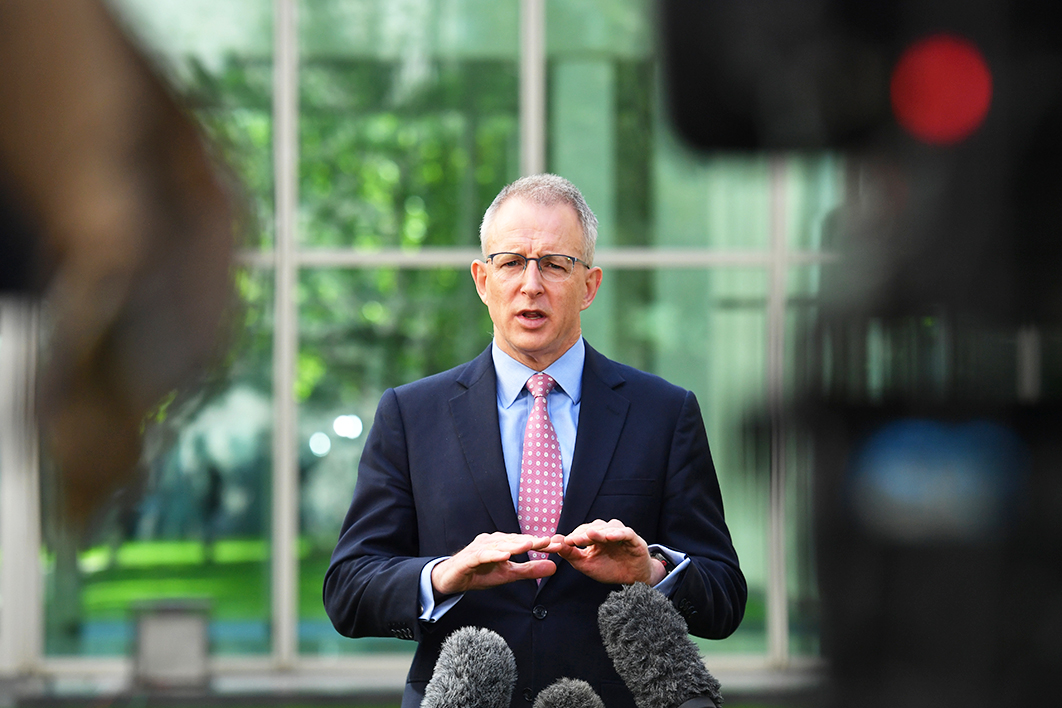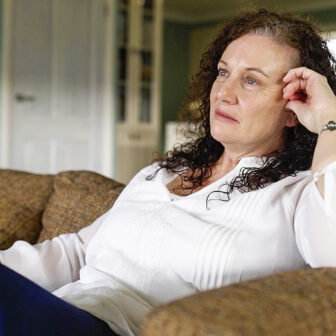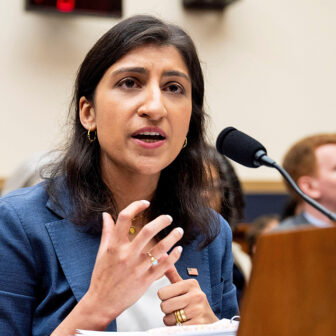Media policy in Australia has not always been made the way communications minister Paul Fletcher is proposing to do it. On 27 November he published a green paper containing some big, surprising ideas about several related policy challenges. Comments have been sought and responders don’t have to whip in their submissions by Christmas Eve. This feels like a genuine invitation to debate difficult questions.
In the distant past, the job of communications department bureaucrats was sometimes less about coming up with innovative policy ideas and more about steaming open correspondence from media moguls before it reached the prime minister’s office. That way the public service at least got an early warning of the likely agenda.
In previous lives, Fletcher wrote and received that kind of correspondence himself. Having worked as a lawyer, corporate strategist, ministerial chief of staff, and corporate and regulatory affairs adviser and consultant, he knows all the games so well that he has little need to play them.
The shift in approach has also been motivated by a changed balance of power in Australian media and communications. The 1980s and 90s were dominated by two big voices, commercial TV and metropolitan newspapers. Telcos were there too, but on media policy they provided a distant chorus, not big solos. Now they are noisier. Add in rising new powers — the overseas-based technology and streaming giants — and governments are faced with too many vocalists to audition individually. You send out the score and let them all sing.
They all matter to media policy and politicians now. TV remains popular with older viewers, and the nightly news is still watched by a lot of voters. Mobile network operators pay big money for radiofrequency spectrum once used by broadcasters. Streaming services attract huge numbers of subscribers and the bulk of viewing time in some demographics. Google, Facebook and Amazon, by some measures, rule not just media and communications but also the world.
Arriving in the portfolio in May last year, Fletcher quickly called a halt to a process of reforming radiofrequency spectrum law that had gone on a long time without much progress. He then restarted it on a new track. Legislation is expected to make it through parliament before the end of the year.
The ACCC was already investigating the impact of online search engines, social media and digital content aggregators on competition in the media and advertising markets. Responding to its report in December last year, Fletcher and other ministers announced a “staged process to reform media regulation.” One of the first steps was to request a paper canvassing options for future regulation of local content on TV. It was released in April, amid growing broadcaster resentment about obligations they faced but their streaming video competitors did not.
In late September, Fletcher responded by announcing that current Australian and children’s content quotas for commercial TV would be replaced by a more flexible, points-based quota system, and pledging additional funding for Screen Australia and the Australian Children’s Television Foundation. In the green paper, he tackles the underlying problem of the long-term sustainability of the free-to-air industry in a world where internet streaming of TV is growing dominant.
The Covid-19 pandemic initially boosted free-to-air TV viewing but smashed advertising revenues, which fell around 15 per cent in 2019–20, increasing the already intense pressure on broadcasters’ costs. While TV audiences are rapidly moving online, the industry is stuck with the high, fixed cost of making five TV networks available to every household in Australia. Transmitters are needed at over 400 sites to do this, as is the Viewer Access Satellite TV service, or VAST, which gets signals to the more than 200,000 households beyond the reach of the terrestrial sites.
Pursuing audiences online brings further costs for broadcasters. Their streamed and on-demand services get to TV sets and other devices because broadcasters, like other video providers, pay to upload their programs to networks of distributed servers known as content delivery networks, or CDNs. Unlike the fixed costs of broadcasting, CDN costs vary with the number of simultaneous users.
Internet streaming also comes with its own gatekeepers. Australian TV networks need the ABC iView, SBS On Demand, 7plus, 9Now and 10Play apps to be “discoverable” in a crowded online landscape where they are important but hardly dominant players. Their aggregate online audiences are smaller than either of the market leaders, Netflix and YouTube, who buy colourful buttons on most TV remote controls. Apple TV+ comes pre-installed on Apple devices as well as on many smart TVs manufactured by Samsung, LG, Sony and others. “Chromecast with Google TV” is the search giant’s latest crack at conquering home entertainment. Amazon lures subscribers to Amazon Prime through premium shipping deals.
To compete with these and other global video giants, local networks must create and maintain a version of their network apps customised for every app marketplace, including every brand of TV receiver. TV manufacturers expect local broadcasters to pay for a conspicuous place, or sometimes any place at all, on the start-up menus of their “smart” TVs. Samsung has started competing with them on their own patch, launching a TV streaming service available free to all owners and purchasers of late-model Samsung smart TVs, carrying thirty channels (in Australia, that is — in the United States the figure is one hundred) including Bloomberg TV+ and Fuel TV.
The Covid recession has made the issue of broadcast TV’s high, fixed transmission costs a whole lot more pressing. This is the backdrop to Fletcher’s green paper. Governments have shown themselves prepared to spend on an extraordinary scale this year but the growing deficits have sharpened the search for savings elsewhere.
The green paper suggests that if enough TV broadcasters are interested in squeezing down to a smaller number of channels, thereby vacating some spectrum, the federal government might be willing to lighten their tax burden and tip an unspecified share of the spectrum auction proceeds their way. This is where the range of possible moves starts to get very complicated.
Broadcast television uses spectrum in the UHF and VHF bands (ultra and very high frequency) to deliver signals to aerials on roofs and inside homes. In Australia, TV spectrum is divided into five blocks, each containing six channels 7 MHz wide. One block of channels is used at every transmission site: for example, the main Sydney transmitters (feeding the tall towers on the Lower North Shore) use Block A on the chart below, the infill transmitters at Kings Cross use Block B and those at Gosford use Block D.
Each of those blocks can be reused at other places across the country, provided they are sufficiently far apart. So Block A, for example, is also used for the main stations in Brisbane, Canberra and Melbourne. Transmitters at each location carry the five networks (Seven, Nine, Ten, ABC and SBS) or their non-metropolitan franchisees (such as WIN, Prime and Southern Cross Austereo). The sixth channel in each block is mostly vacant.
Australian mobile network operators want the government to encourage TV out of this band. The federal government is keen to help for two reasons. First, it funds two of the five broadcasters, the ABC and SBS, and therefore pays their TV transmission bills. These might be reduced under some scenarios.

Australia’s TV bands: The top bar shows spectrum used before digital switchover. The middle bar shows the five blocks currently used. The bottom bar represents the North American 600 MHz “second digital dividend.”
Second, it receives the revenue when vacated spectrum is sold. Between 2001 and 2017, switching TV broadcasters from analogue to digital transmission netted over $3 billion from selling the vacated “digital dividend” spectrum to the big mobile operators who now use it mainly for 4G services. Australia’s digital dividend comprised the UHF frequencies 694–806 MHz, colloquially known as the 700 MHz band. Recovering some of the spectrum still used in the 600 MHz band would represent a second digital dividend. There won’t be as much of it as the first one, but large sums are still likely to be offered.
How to pack the TV services currently carried across five blocks of frequencies into the spectrum currently occupied by only three of those blocks is a great challenge with political and social, as well as technical, dimensions.
If mobile operators are going to get the 600 MHz band spectrum they want, at least some TV services are going to have to move — somewhere, somehow, and sometime soon. We have been looking at this issue and recently explored five options in an article in the Journal of Telecommunications and the Digital Economy. The minister’s green paper implicitly looks at the first two: a “minimalist model” involving an upgrade to the existing transmission system; and a full replacement of the current transmission standard with a new, specialised broadcast platform, most likely “DVB-T2” (the enhanced version of the DVB-T system that Australia currently uses).
Each of these would improve the efficiency of transmission, although conversion to DVB-T2 would be much the bigger deal — more efficient, but also a lot more expensive. Industry has been talking about DVB-T2, even conducting a couple of trials, for years now, but it has never been clear where the money would come from.
We also considered more radical options: shifting broadcast TV entirely to online or satellite delivery, and some form of hybrid solution that combines elements of them all. We concluded that the last of these, a hybrid, is the most likely outcome.
A new or upgraded transmission standard would allow broadcasters to transmit more TV “channels” or better-quality images — HDTV instead of SD, 4K instead of HDTV, or a combination of the two. But the primary impetus for change today is not to deliver more or better TV. It is financial: to reduce the costs of transmission and enable a future change in use of the 600 MHz spectrum. That would require TV broadcasters to consolidate their capacity and cooperate to a degree that has not previously been mandated, although they have sometimes chosen to do it. This would not only change the transmission standard but also overthrow one of the historical pillars of the Australian TV industry: the ability of each licensed broadcaster to operate, or direct the operation of, its own transmitters. Radio broadcasters have already cooperated for digital radio, but TV? TV is different.
Fletcher’s green paper proposes offering commercial TV broadcasters a one-off, irrevocable chance to elect to stay with their existing licences or move to new ones. New licence holders would enjoy an immediate and permanent holiday from spectrum taxes and be subject to slightly reduced content obligations. (Commercial TV operators have been paying aggregate taxes of around $41 million per year for access to their TV channels, although these were temporarily waived this year as a Covid-19 industry support measure.)
In return, the government may require them to consolidate their services onto a single TV channel with one or more other TV networks. (This is known as “multiplex sharing,” after the device that consolidates multiple streams of TV for transmission.) The government would do so if at least two of the three commercial networks in each area elected to move to new licences. Instead of using three TV channels in each area, commercial TV would use two, or perhaps even one, with participating broadcasters entering into channel-sharing arrangements.
If enough commercial broadcasters so chose, the ABC and SBS would also be directed to move to a single, shared multiplex. Together, these consolidations would generate the necessary reduction from five multiplexes — and spectrum blocks — to the magic number, three, that would allow a US-style 600 MHz second digital dividend.
But the move to three multiplexes would almost certainly require a reduction in the current suite of free-to-air TV channels. By how much? The green paper proposes that broadcasters switch to the “new” digital compression standard (MPEG-4) that they are already using for some services, which is roughly two-thirds more efficient than the existing compression standard (MPEG-2), which has been used since digital TV was launched. The actual benefit yielded may be smaller, as broadcasters are already inserting MPEG-4 content.
So far, the upgraded compression standard has been used mainly to add services like Seven’s Racing.com and carry the HD versions of each broadcaster’s primary channel. Broadcasters have been transmitting increasing amounts of content in MPEG-4 for several years now, but full conversion has been delayed by concerns that some older TV sets won’t be compatible. But with MPEG-4 standard in most new TVs for so long, very few viewers are likely to notice the change.
For government, the current proposal would provide a very fast track to a massive spectrum sale while cutting the cost of ABC and SBS transmission. The high uptake of MPEG-4-ready TVs might suggest few viewers would face blank screens, though we’d need to make sure their TVs deal smoothly with a multiplex-sharing scenario that wasn’t on the cards when the receiver standards were written. ABC and SBS, at least, would need to cut back on the suite of channels they offer. This ground was tilled exhaustively in 2015, when previous minister Malcolm Turnbull first proposed multiplex consolidation for the two broadcasters.
If no deal is struck this time, then industry, government and viewers will still be facing the range of future options that are the subject of our article. While the green paper is right that the sustainability of local TV is in play, from a viewer standpoint the transmission cost issue is also fundamentally about inclusion — how can Australia most affordably make available a comprehensive and appropriate range of local TV services to the millions of viewers, and voters, in the vast, expensive-to-serve areas outside capital cities?
Some people, especially the many who now watch little or no broadcast television, will wonder why we are even thinking about such a complex shuffle. Isn’t this why we built a National Broadband Network that is now virtually complete? The NBN shares something significant with the broadcasting system — it’s designed to offer services to every home or business in Australia — so why not get broadcast TV out of over-the-air transmission altogether, and reallocate all its spectrum at an end-of-season, last-days-must-close, digital-dividend sale?
Shifting all broadcast TV services online would be a big, bold strike, integrating broadcasters decisively into the distribution platform that is already carrying the video streaming and sharing services and apps that are drawing such big audiences. It is not exactly the same as shifting Australian TV from wireless to a fixed-line network, the old “Negroponte Switch,” because for around 8 per cent of premises NBN is either a fixed wireless or a satellite network. Nor is the NBN the only way users access broadcast TV now that mobile broadband in Australia is so fast and cheap and all networks stream their services live. Indeed, some commentators are already suggesting that TV broadcasters’ real transmission future lies with 5G wireless.
The awkward paradox for broadcasters is that the medium viewers are turning to for more and more of their video needs is not a ready, near-term replacement for broadcast TV. With people working and entertaining themselves at home, Covid-19 lockdowns provided a test run for a big increase in online video consumption. Peak downstream network throughput on NBN’s main wholesale broadband service increased by 44 per cent between February and the last week of November during the Evening Busy Hours (8pm to midnight) and more than a quarter in Peak Business Hours.
There was some help: NBN temporarily reduced network access prices for broadband service providers, and “over-the-top” video streaming and conferencing services lowered their bit-rates. The government later announced investment to upgrade the network. How successfully an even bigger traffic shift might be handled in the future, and what it would cost broadband service providers and therefore their customers, is heavily dependent on what people will watch and when, and on future NBN access prices.
Broadcast TV — seemingly a declining asset as viewing preferences have atomised – has the great advantage of being able to absorb, seamlessly and without extra cost, those moments when everyone chooses to turn on the television. Australian governments will remember well Optus’s network meltdown when it tried to exercise its exclusive rights to transmit the 2018 FIFA World Cup finals to Australians via online streaming, a fiasco from which it was rescued by the SBS’s broadcast TV service.
These occasions can be unpredictable. British prime minister Boris Johnston’s messages to the nation in March and May 2020 were Britain’s most-watched broadcasts since the closing ceremony of the 2012 London Olympics. His 10 May broadcast about the easing of lockdowns drew an astounding 90 per cent viewing share to the seven channels that carried it. At such times, politicians don’t want viewers relying on networks that melt.
Arguably the biggest transformation embodied in a complete shift to online delivery would be the loss of broadcast television’s free-to-air accessibility. A service that is enduringly popular with older, potentially vulnerable consumers would no longer be effectively free at the point of consumption, but would depend on paying for a fixed or mobile broadband subscription. It seems unlikely that anything less than 100 per cent network availability and take-up would be politically palatable as a replacement for terrestrial TV, especially when, as Telstra’s annual Australian Digital Inclusion Index highlights, the gaps between digitally included and excluded Australians are still “substantial and widening for some groups.” During the pandemic, the Index’s authors found that older people, families without adequate internet access, and vulnerable Australians have been “especially isolated.”
The other candidate for a larger role in TV’s future is direct-to-home, or DTH, satellite delivery. This has considerable technical and economic attractions and may seem conceptually straightforward because 200,000+ households already receive TV this way from the VAST service. In practice, it would be extremely contentious with viewers and hence politicians.
While satellite DTH plays a much bigger role in TV distribution in New Zealand and many other countries, it would be costly for the many households that don’t already have a satellite dish for Foxtel (if the same satellites were used) or for all viewers (if satellites other than Foxtel’s were used). It would also require the VAST service to be re-engineered and expanded to incorporate all TV networks and accommodate the separate programming and advertising break-outs they currently deliver to discrete local service areas.
But satellite has an advantage that may ensure it remains a part of the TV transmission solution — it can serve vast, sparsely settled areas cheaply. Experiences in the very few overseas markets where terrestrial TV is shutting down suggests satellite may one day provide the final safety net.
Television in Australia has been a lot more than “broadcasting” for a long time. It is now a sprawling, overlapping amalgam of the national and commercial broadcast services that founded the medium, the subscription broadcast and narrowcast services that joined it 40 years later, and the many types of online video that are received over a variety of fixed and mobile networks. It is a hybrid. We should not be surprised if it resists efforts to put it back into a single box, the kind of “black box fallacy” that American media scholar Henry Jenkins warned about in his 2006 book Convergence Culture: Where Old and New Media Collide:
Sooner or later, the argument goes, all media content is going to flow through a single black box into our living rooms (or, in the mobile scenario, through black boxes we carry around with us everywhere we go)… Part of what makes the black box concept a fallacy is that it reduces media change to technological change and strips aside the cultural levels.
Seeking to answer the questions posed in the government’s green paper, it will be important not just to solve today’s pressing problems but to try to set up for what we might want to do tomorrow or, at least, to avoid unnecessarily constraining the options.
There is much more to the green paper than just a proposal to harvest the extra efficiency of a new compression standard to repurpose some valuable spectrum. The offer to broadcasters is an opening gambit; the paper issues an invitation for any better ideas about TV’s future. It acknowledges the public policy heavy lifting done by TV in telling Australian stories and ensuring the wide availability of local news.
To help secure a more sustainable future for the local industry, it proposes that the largest Subscription Video on Demand and Ad-based Video on Demand services would be required to spend a proportion of Australian revenue on local content, and would be subject to obligations to make that content discoverable. This brings more singers to the media policy choir, including production industry unions, guilds and employer associations, and representatives of people living in non-metropolitan areas.
What happens from here? First, submissions and discussion. Then government decisions and legislation, and debate in parliament, especially the Senate. Then, if something like the green paper scheme goes ahead, TV broadcasters, market by market, will elect to take one option or another. In his current life, Paul Fletcher knows all about elections. •
Research for this story and the article it refers to was supported by the Australian Research Council through ARC DP 150100887, “Spectrum After Scarcity.”




